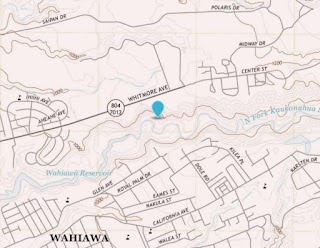Hawaii Route 7012 is a 1.9-mile State Highway located on the Island of O'ahu. Hawaii Route 7012 begins at Hawaii Route 80/Kamehameha Highway and follows Whitmore Avenue east to the Wahiawa Naval Reservation. Hawaii Route 7012 was once assigned as Hawaii Route 804 and still appears as such on some maps.
This page is part of the Gribblenation O'ahu Highways page. All Gribblenation and Roadwaywiz media related to the highway system of O'ahu can be found at the link below:
https://www.gribblenation.org/p/gribblenation-oahu-highways-page.html
Part 1; the history of Hawaii Route 7012
Prior to the Statehood the first signed highways within Hawaii Territory came into existence during World War II. During World War II the territory of Hawaii saw an influx of military activity following the attack on Pearl Harbor on December 7th, 1941. Numerous Military Routes and early Hawaii Routes were signed through the Hawaiian Territory to aid military personnel in navigating the islands. Military Highways were assigned US Route style shields whereas lesser highways were assigned an early variation of what is now the Hawaii Route Spade.
A 1946 Army Map of the Island of O'ahu shows the future corridor of Hawaii Route 7012 is shown to partially be on the alignment of Hawaii Route 124. Hawaii Route 124 is shown diverging from Whitmore Avenue onto what is now Saipan Drive. A full version of the 1946 Army Map of O'ahu can be seen on hawaiihighways.com here.
Circa 1955 following the conclusion of World War II the United States Bureau of Public Roads renumbered the Hawaii Route System. The 1955 Hawaii Route Renumbering saw most of the conventions utilized by the current Hawaii State Route System established. Primary Hawaii Routes were given two-digit numbers whereas Secondary Hawaii Routes were given three-digit numbers. The Hawaii Routes were assigned in sequence for what Island/County they were located on coupled with what Federal Aid Program number they were tied to. In the case of Whitmore Avenue it was not assigned one of the initial post-1955 Hawaii Route numbers. Whitmore Avenue can be seen on the 1959 Gousha Highway Map of Hawaii branching east from Hawaii Route 80/Kamehameha Highway near Wahiawa.
The post-1955 designation history of Whitmore Avenue isn't fully clear, but it can be seen as Hawaii Route 804 on the 1983 USGS Map of Wahiawa.
For unknown reasons Whitmore Avenue appears as both Hawaii Route 804 and Hawaii Route 7012 on the 2017 USGS Map of Wahiawa.
North of the Karsten Thot Bridge Hawaii Route 80/Kamehameha Highway intersects Hawaii Route 7012 at Whitmore Avenue. No route number is seen on Hawaii Route 80 northbound at Whitmore Avenue.
At Whitmore Avenue southbound Hawaii Route 80 intersects Hawaii Route 7012. From southbound Hawaii Route 80 southbound a single Hawaii Route 7012 shield can be found.
During June 2019 Dan Murphy of the Roadwaywiz YouTube Channel (and Gribblenation) featured real-time drives on Hawaii Route 7012. Below eastbound Hawaii Route 7012 on Whitmore Avenue can be observed.
Below westbound Hawaii Route 7012 on Whitmore Avenue can be observed.










Comments